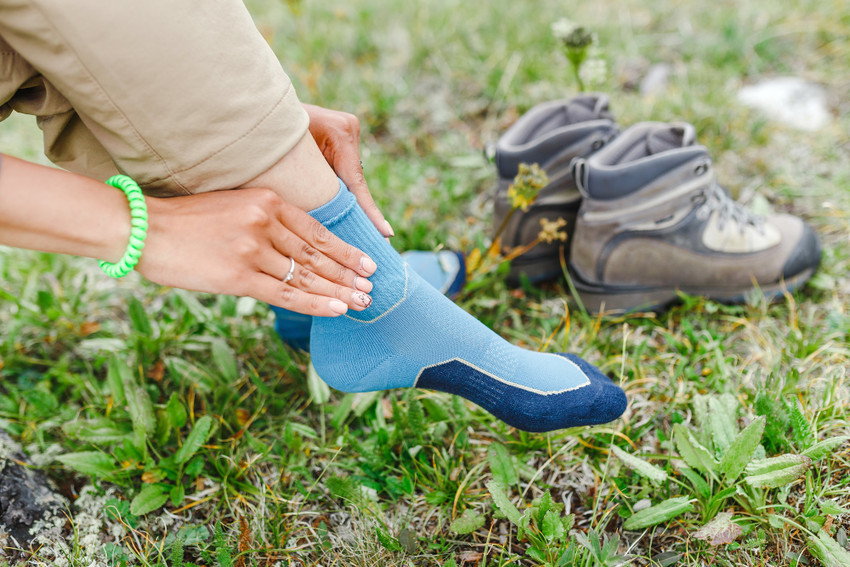The Common Symptoms of Diabetic Neuropathy
Posted by EcoSox on May 8th 2023
Diabetic neuropathy can affect approximately 50% of individuals with diabetes.
What is diabetic neuropathy? It's a type of nerve damage that can occur when high blood sugar levels (high glucose levels) injure nerves in the body. It most commonly affects the feet and legs.
It's important to recognize the symptoms as you can often prevent diabetic neuropathy or at least slow its progress. So, here's what you need to know about the symptoms, as well as how socks for neuropathy can help.
Causes of Diabetic Neuropathy
Currently, the exact cause of diabetic neuropathy remains unknown. However, several factors likely contribute to this disorder, such as high blood glucose levels.
High blood glucose impacts the body by causing chemical changes that damage your nerves. It can cause nerves to stop sending messages to certain parts of the body.
Your nervous system is the body's "command center." It sends neurons with signals that control movements, bodily processes, thoughts, and responses.
Since your nervous system controls how you touch and feel, it also plays an important role in preventing damage to the body. For instance, if you touch a hot stove, your nervous system should send a warning signal like "that's hot!" As a result, you'd normally pull your hand back immediately.
If you're diabetic and you have nerve damage, you may experience increased sensitivity or phantom sensations. Individuals with diabetic neuropathy may not notice pressure or injuries, especially on the feet. Without proper care, these injuries can become infected.
Other factors that can lead to this condition include high cholesterol and high triglyceride levels, obesity, and genetic traits.
Types of Diabetic Neuropathy and Common Symptoms
There are four types of diabetic neuropathy: focal/mononeuropathy, polyneuropathy, autonomic neuropathy, and proximal neuropathy.
Here is a brief description of each and the commonly associated symptoms.
Focal Neuropathy
Also known as diabetic mononeuropathy, this type of nerve problem affects one nerve at a time. Therefore, the symptoms can vary depending on the affected nerve. Individuals may experience numbness or pain in the chest area or in their lower back, for instance.
Common symptoms and areas affected include:
- Difficulty focusing your vision
- Aching behind the eyes
- Double vision
- Difficulty hearing
- Pain in one area (such as the thighs, back, stomach, etc.)
- Weakness in the hands that may cause you to drop objects
- Paralysis on one side of the face (Bell's palsy)
- Numbness or tingling in your fingers or hands
Diabetic Polyneuropathy
Diabetic polyneuropathy (DPN) is a type of nerve damage that impacts multiple parts of the body, including motor and sensory nerves. The nerves that branch out from the spine to the feet are usually the longest and most commonly affected.
There are two types of diabetic polyneuropathy: autonomic and proximal.
Symptoms of DPN include:
- Tingling, burning, or prickling sensations
- Numbness in the feet, legs, or hands
- Muscle weakness in the hands or feet
- Increased sensitivity (especially at night)
- Pain or cramps
- Decreased sensitivity to pain and temperature
- Lack of coordination or difficulty balancing
Since DPN can cause insensitivity to temperature and pain, individuals with this type of nerve damage may not notice when they injure themselves. Injuries along the feet and toes are quite common, as they are difficult to notice without proper care. Unfortunately, this can cause ulcers and infections and sometimes lead to amputation.
Approximately 150,000 patients in the United States undergo a lower extremity amputation every year. Diabetes mellitus and neuropathy are two of the most common reasons patients require amputations.
Mild cases of neuropathy can go years without being noticed. Unfortunately, untreated DPN can cause further damage to other parts of the body, including the eyes, sexual organs, and digestive tract.
Peripheral Neuropathy
Peripheral neuropathy relates to the nerves located outside the brain and spinal cord. The peripheral nervous system sends information to your spinal cord (central nervous system) and your brain.
Diabetes is one of the most common causes of peripheral neuropathy.
Peripheral neuropathy may fall into the mononeuropathy or polyneuropathy category, depending on how many nerves it affects. However, most people with diabetes experience polyneuropathy.
Diabetic Autonomic Neuropathy
Autonomic neuropathy impacts the autonomic nerves or the ones that connect to internal organs, the digestive system, the heart, the urinary tract, sweat glands, and other processes.
Individuals with autonomic neuropathy may experience the following symptoms:
- Diarrhea or constipation
- Nausea or vomiting
- Sexual dysfunction
- Low blood pressure
- Unusual sweating
- Insensitivity to pain
- Hypoglycemia
Proximal Neuropathy (Diabetic Amyotrophy)
Proximal neuropathy has many names, including diabetic amyotrophy. This is a relatively rare condition that only occurs in about 1% of type 2 diabetes patients. Older adults are the ones most commonly affected.
The primary symptom is pain that begins in the upper thigh, although it can spread to the hip and lower back. Some patients also experience weakness in addition to pain.
Another symptom that affects some patients with diabetic amyotrophy is unexpected weight loss.
The condition can progress and cause pain in other body parts, including the upper and lower legs.
How Socks for Neuropathy Can Help With Symptoms
Like many chronic medical problems, diabetes can cause symptoms throughout your life of varying severity. Patients with diabetic neuropathy or those that want to prevent it can take steps to stay healthy. Regularly looking for these symptoms and frequently checking your feet for cuts or wounds definitely helps.
Using socks for neuropathy can also protect your feet and help with symptoms.
Diabetic socks and edema socks provide both comfort and protection. They help to increase blood circulation, keep feet dry, prevent blisters, and also support the foot for less fatigue.
Traditional cotton socks have seams that can irritate the foot and cause discomfort. Cotton socks also retain moisture and take longer to try, making them less than ideal for hiking and exercise.
Bamboo viscose socks have a softer feel that reduces friction and wicks moisture away better than cotton.
Recognize the Signs of Diabetic Neuropathy
This article should help you to identify the signs and symptoms of diabetic neuropathy. If you recognize any, talk to your doctor.
Taking precautions will help you protect your feet from damage. Wearing the right socks for neuropathy can improve comfort and prevent injuries such as sores and blisters.
Here at EcoSox, we have a variety of different styles for both men and women. Shop our styles, such as our popular diabetic bamboo crew socks.

